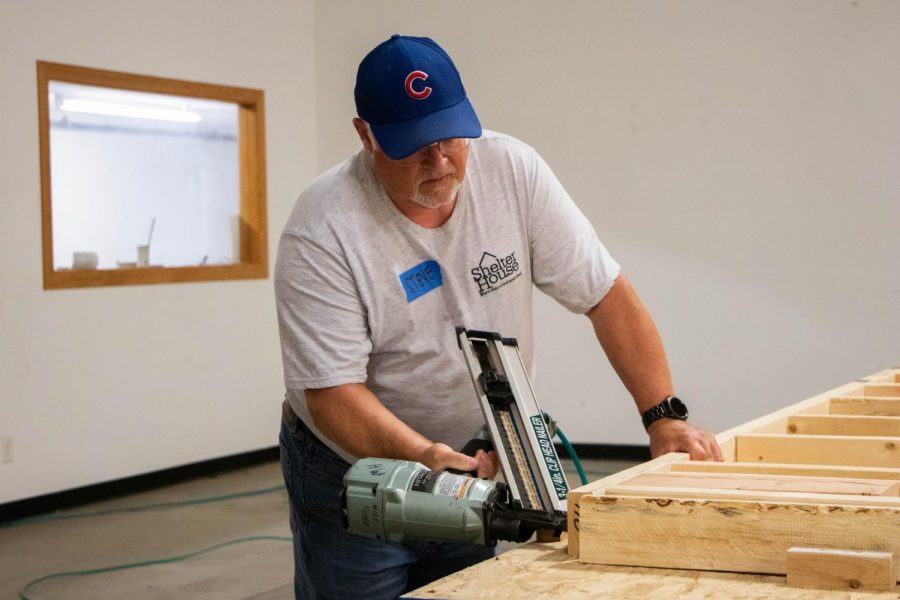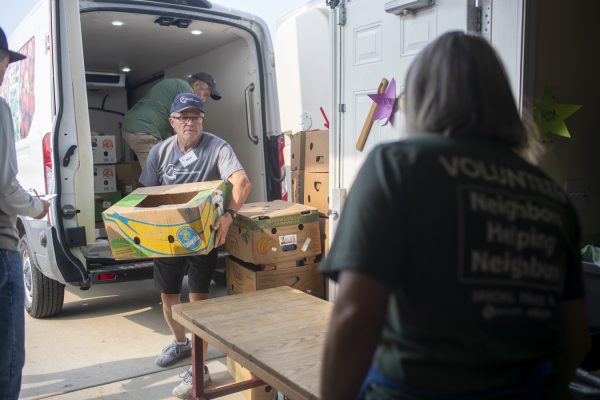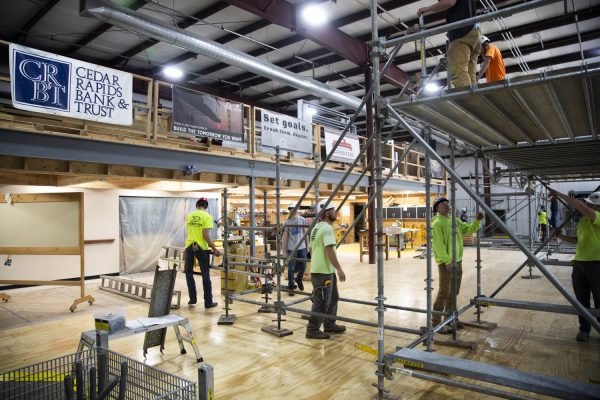Shelter House to provide 36 single adult housing units at The 501 Project
The building will follow a Housing First model to provide housing for single adults experiencing chronic homelessness.
Steve Schornhorst, the construction manager on the Shelter House’s board, helps build some walls for The 501 Project at a volunteer build before the ceremony on Thursday.
June 17, 2021
Shelter House is building a second Housing First facility to address a shortage of housing options for Iowa City residents experiencing homelessness.
The 501 Project, located right next to the Shelter House emergency shelter on Southgate Avenue in Iowa City, will provide housing to 36 single adults.
Crissy Canganelli, the executive director of Shelter House, spoke to a crowd of Shelter House staff, volunteers, partners, and stakeholders at the construction site on Thursday night.
“The 501 Project is a demonstration of our commitment and progress as a community to realign resources from both public and private sectors from managing homelessness to ending it,” Canganelli said. “For what is the solution to homelessness, if not housing?”
The Housing First model assists people who are chronically homeless by giving them access to affordable housing with reduced barriers to entry.
Shelter House opened its first Housing First facility — Cross Park Place — in January 2019.
Several years of research by Shelter House and other community providers before Cross Park Place opened found that the average cost for four individuals to cycle through different public services while remaining homeless is about $140,000 per person per year.
These services can include, but are not limited to, law enforcement, health care, and social services.
“It was through that experience not only that we educated ourselves about Housing First, but our community… and offering housing intervention through this very low barrier method of saying, ‘You’re homeless, you need housing, we have this housing unit through this broad spectrum of stakeholders and partnerships, we’re able to support and guarantee that housing and sustain it,’” Canganelli said.
Canganelli said in Cross Park Place, which has 24 units, the total population they house went from spending thousands of nights in jail to just a handful.
She said their stability, health, and wellness increased and the cost of their emergency health care services was reduced by about 90 percent.
Canganelli told the crowd on Thursday that she has seen people’s lives change on an individual case basis with the Housing First model.
“[I am] not trying to say that people give up drinking, [or] all of a sudden become med-compliant,” she said. “It is a gradual process and people are self-identifying their growth, but the biggest thing, first and foremost thing, is that they’re staying housed.”
When Cross Park Place opened the unit waitlist, about 90 people signed up, she said, so Shelter House knew there was an urgent need to make more units available.
Shelter House received a National Housing Trust Fund loan of $2.7 million and over $1 million from the Housing Trust Fund of Johnson County, but Shelter House itself is also taking on commercial debt so the building can be available as soon as possible, Canganelli said.
Canganelli said she expects the construction to last until May or June 2022.
For individuals to qualify for residence at The 501 Project, they must meet the Housing and Urban Development definition of chronically homeless, as The 501 Project collects project-based vouchers.
Unlike other housing solutions, Housing First does not require tenants to be sober or engage with any services to receive housing. Canganelli said support services will be available for individuals, but their use isn’t a requirement as a condition of tenancy.
“Housing First guarantees an individual access to housing, and it also guarantees the access to the support services that may be necessary to retain that housing to address health issues and regain health and wellness, but it does not require a tenant or participant to engage in those services,” she told The Daily Iowan.
RELATED: Iowa City City Council votes to move ahead with Hickory Hill Housing plan
Tenants will pay 30 percent of their income for rent, and rent is guaranteed through the project-based voucher. People with no income will pay zero dollars in rent.
Brycen Myers, a 2020 University of Iowa alum, started working in the street outreach position at Shelter House in April, after working as a housing case manager.
He said the Housing First approach allows Shelter House to assist the widest range of people possible.
“Here we believe that housing is a human right, so we start with the house,” Myers said. “And then if you choose that you want to address your substance abuse later, then we will help you do that. If you choose not to, that is completely fine because you still deserve housing.”
In attendance at the ceremony Thursday afternoon were several local elected officials, including Johnson County Supervisors Rod Sullivan and Jon Green, Iowa City City Councilor Janice Weiner, and state Sen. Joe Bolkcom, D-Iowa City.
“The need is enormous everywhere in Iowa for affordable housing. [The legislature] made a few good moves this session, but it’s a problem that’s not going to go away with one session’s worth of work,” Bolkcom said. “So, I hope we can get more resources behind organizations like Shelter House and on the Housing Trust Fund here in Johnson County.”
The 501 Project building will be three stories tall. The first floor will consist of offices, clinic spaces, congregate areas, and the second and third floors will have 36 total units for single adults.
Steve Schornhorst, the construction manager on the Shelter House’s board, helped build some walls for the building at a volunteer build before the ceremony on Thursday.
He worked in construction for 43 years, but he hasn’t physically pounded nails for 30 years, Schornhorst said. Knowing his efforts are going to an important cause makes it worthwhile, he said.
“It makes the work easy,” he said. “I know it’s going to help people, that’s why I’ve been on the board for so long.”















